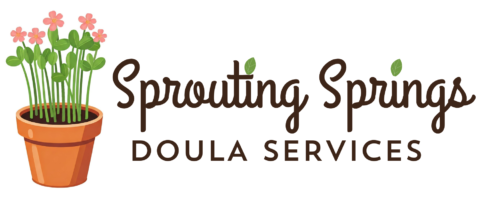
The first weeks postpartum are a time for slowing down, healing, and practicing as much self-care as possible. In this post you will learn what to expect and what to be aware of in the first weeks postpartum. While the postpartum experience is always unique, there are many common experiences and ways to support healing. This post will discuss bleeding, afterpains, perineal soreness, and cesarean birth recovery. If you are concerned about any symptoms, don’t hesitate to contact your provider.
Postpartum bleeding
Postpartum vaginal discharge is called lochia, and this can last up to 6 weeks. In the first 4 days postpartum it is normal to expect bright red, heavy-flow discharge with small to medium clots. This is followed by pinkish-brown discharge with fewer clots, lasting up to 10 days postpartum. For the remainder of the first 6 weeks postpartum, yellow or white discharge with minimal blood and no clots is to be expected. If discharge reduces and then increases after physical activity, consider it a reminder to slow down.
Seek immediate medical attention if:
- Lochia is green, fishy smelling, or you have a fever
- You have golf-ball-sized clots
- You are soaking through a pad in an hour or less
Afterpains
Following giving birth, the uterus will need to return to pre-pregnancy size, this is called uterine involution. The contractions that guide this process are called afterpains. They often happen while breastfeeding due to the release of oxytocin.
To help with the intense cramping during the first 6 weeks postpartum:
- Use over-the-counter pain relievers as recommended
- Apply a hot water bottle or heating pad to the area
- Drink red raspberry leaf tea
- Spend a few minutes in child’s pose with butt up (see photo)

Perineal Healing
The healing time of the perineum following a vaginal birth will depend on if there was tearing, and if so, the severity.
Whether healing from a tear or not, there are ways to ease discomfort:
- Sitting on padded surfaces
- Cooling the wound with a
- Wrapped ice pack
- Chilled witch hazel on a pad
- Squirt bottle of warm water while urinating
- Sitz baths
Contact your medical provider if you are experiencing:
- Severe pain
- Pain that gets worse
- Pain that won’t go away
- Fever
- Fecal or urinary incontinence
Cesarean Birth Recovery
A cesarean birth is a major surgery with a recovery often more intense and longer than the recovery from vaginal birth. Recovery will include not lifting anything heavier than 25lbs, waiting a minimum of 6 weeks before using a tampon or engaging in sexual intercourse, and waiting 1-2 weeks before driving, as movement is likely to be difficult. During the second week, the incision may be itchy. The incision site will need to stay clean and dry to prevent infection.
Contact a provider if you experience:
- Incision site is red, swollen, or leaking
- Worsening pain
- Fever
- Overwhelming fatigue
More information can be found at:
Postpartum care: https://www.mayoclinic.org/healthy-lifestyle/labor-and-delivery/in-depth/postpartum-care/art-20047233
Postpartum timeline: https://my.clevelandclinic.org/health/articles/postpartum.
Vaginal Tearing: https://www.mayoclinic.org/healthy-lifestyle/labor-and-delivery/in-depth/vaginal-tears/art-20546855
Postpartum recovery: https://www.healthline.com/health/postpartum-recovery-timeline
Cesarean Birth: https://www.mayoclinic.org/tests-procedures/c-section/about/pac-20393655
